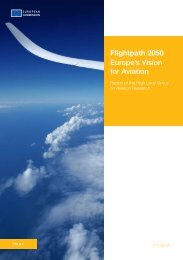Create
Final Report - Acare
Final Report - Acare
- No tags were found...
Create successful ePaper yourself
Turn your PDF publications into a flip-book with our unique Google optimized e-Paper software.
44<br />
The work of the assessment panels will be<br />
to judge the impact of each idea on each of<br />
the 23 main system attributes. For this the<br />
SP2 process requires a uniform ranking scale<br />
defined both in abstract terms as well as in<br />
numerical terms to allow mapping against<br />
the top level issues. The CREATE team defined<br />
the ranking scale as a numerical value with<br />
a 5-point scale from: strongly positive at +3<br />
points ,weakly positive at +1 point, neutral=0,<br />
and similar marks on the negative side.<br />
For the purposes of the CREATE assessment<br />
process we consider a “neutral” ranking to be<br />
the minimum value required for an idea to be<br />
worthy of incubation for each criterion ranked.<br />
While the set of criteria presented above was<br />
designed to be as comprehensive as possible,<br />
given the wide range of ideas likely to be<br />
submitted to the IDEA Portal it is possible<br />
that some criteria may not be significant<br />
with respect to a specific idea. In this case<br />
it is possible to rank these criteria as “not<br />
applicable”. Basically, this special ranking<br />
is similar to “neutral” but can be used to<br />
normalise the overall rankings of ideas. Further<br />
notes are at Appendices A & B.<br />
It is evidently necessary to define for each<br />
criterion a precise interpretation of the<br />
marking. At Appendix B examples of the<br />
recommended detailed descriptions for the<br />
second level criteria are shown. Such a detailed<br />
listing was found to be necessary during<br />
the trial assessment activity when questions<br />
arose regarding the semantics and intended<br />
interpretations for the criteria. Certainly this<br />
affected some criteria more than others and<br />
this is why the lengths of the descriptions<br />
differ greatly. In addition, for each criterion<br />
there is an explanation given on how to<br />
apply the ranking scale. The descriptions of<br />
the criteria and the ranking instructions are<br />
intended to remove personal bias from the<br />
assessment as far as possible. However, there<br />
may be cases in which the ranking instructions<br />
will not fully match the particulars of a given<br />
idea. In these cases the ranking instructions are<br />
to be considered as guidelines outlining the<br />
intentions behind a criterion.<br />
6.6.5. Lessons Learnt<br />
The assessment process and the criteria set<br />
have evolved over the duration of the CREATE<br />
project. In February 2010, the set of assessment<br />
criteria presented above was tested twice by<br />
being subjected to assessment activities. It was<br />
first tested by a group of Bauhaus Luftfahrt<br />
scientists and then by a session of academia<br />
and industry stakeholders. These two test<br />
activities produced useful feedback on the<br />
criteria set as well as on the overall process.<br />
Based on this feedback several issues were<br />
identified that are particularly important.<br />
Ethics as a criterion<br />
The assessment criterion “Ethical constraints”<br />
caused numerous discussions throughout the<br />
assessment workshop. The discussions related<br />
to the scope of applicability of this criterion as<br />
well as to the exact application of the ranking<br />
scale. Still, the discussions evolving around the<br />
ethics of ideas were seen as an indicator that<br />
a criterion of this kind must be included in<br />
the criteria set. As a result of these discussions<br />
we formulated an extended definition for<br />
this criterion. We are well aware that our<br />
definition is neither fully exact nor fully<br />
comprehensive but should serve as a useful<br />
guideline for assessment panel members.<br />
Orthogonality of the criteria set<br />
One problem of the early versions of<br />
the criteria set was its inherent lack of<br />
orthogonality. Orthogonality in this context<br />
means that every aspect considered relevant for<br />
idea assessment should be covered by exactly<br />
one criterion. However, there were some<br />
criteria that violated this condition. In order<br />
to rectify this issue the criteria set was revised<br />
after the assessment workshop. A number<br />
of criteria that were found to be redundant<br />
or otherwise unsuitable for the process were<br />
dropped while some other criteria subsets were<br />
merged into single criteria.<br />
Assessment panel<br />
The experience gained from the assessment<br />
session suggests that an assessment panel<br />
consisting entirely of aerospace engineers – as<br />
might be expected in an aeronautics activity<br />
– is not necessarily ideal. The assessment<br />
body should incorporate a balanced mixture<br />
of experts from different fields and also a<br />
balanced mixture of visionaries and sceptics.<br />
Preparation of the assessment panel<br />
A diligent and thorough preparation of any<br />
assessment session and of its participants is<br />
of vital importance. This must ensure that<br />
all assessors have a common understanding<br />
of the assessment process, the assessment<br />
criteria and the assessment objectives. The<br />
short briefing held for the assessors on the<br />
assessment objectives at the assessment<br />
workshop turned out to be insufficient. The<br />
goals of the CREATE process differ significantly



